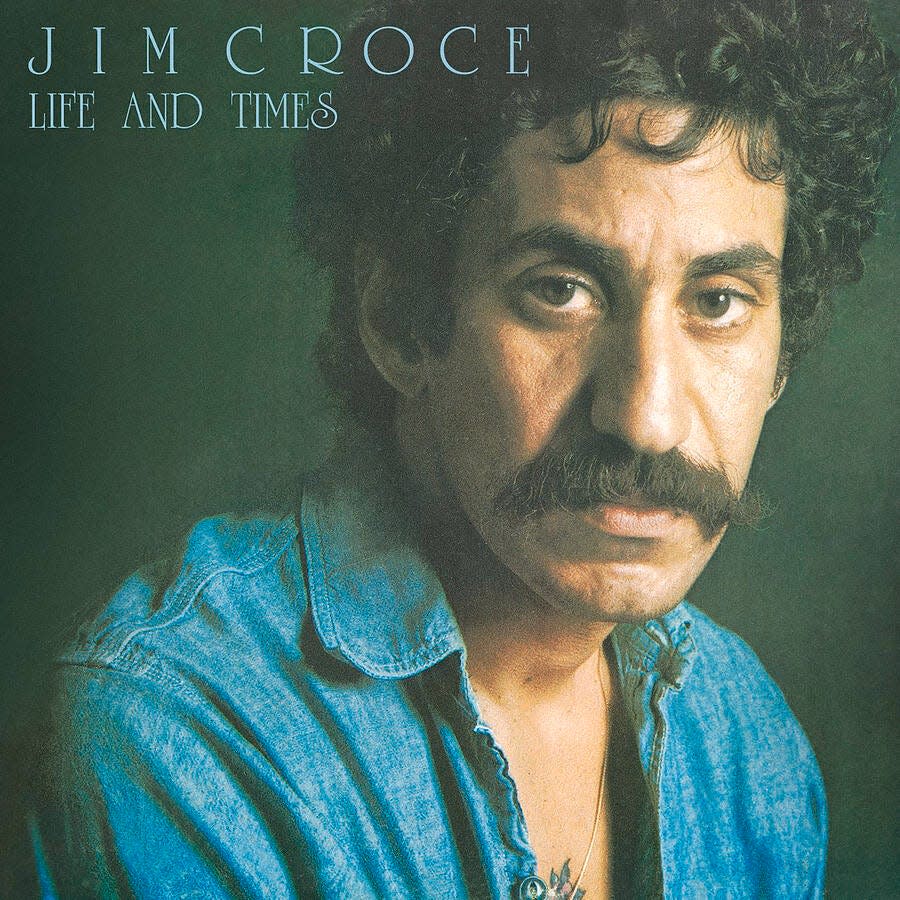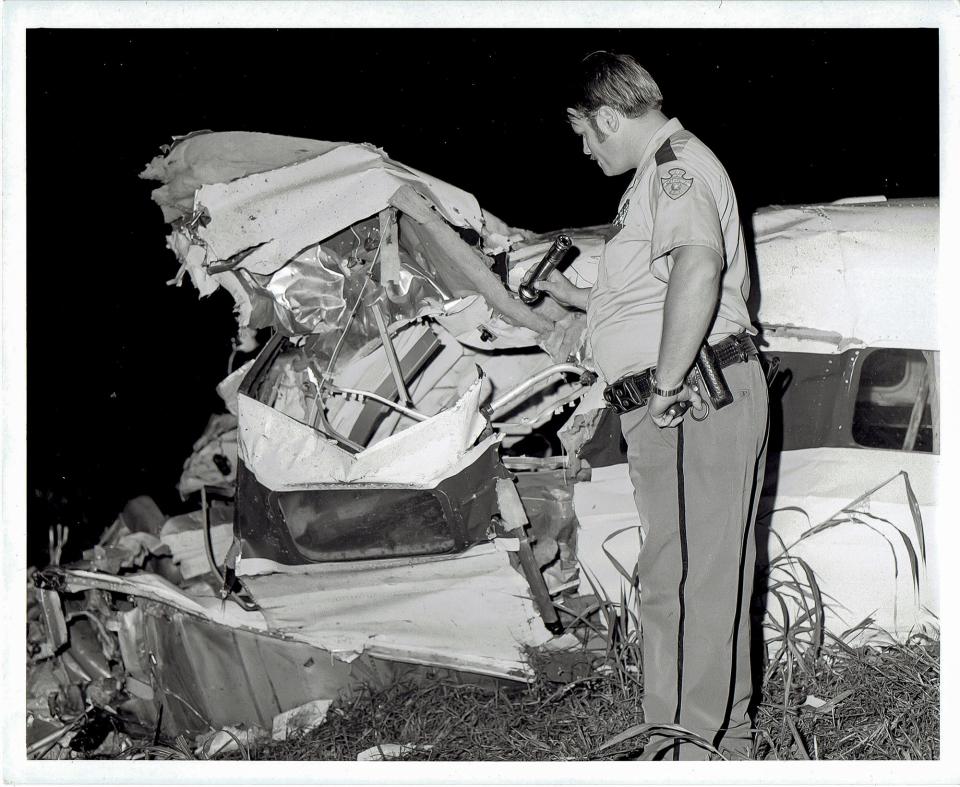Jim Croce died 50 years ago in Louisiana: Here's what happened on that fateful night
Editor's note: The following story was first published by the USA Today Network on Sept. 18, 2019. It's being republished now with minor updates to recognize the week of the 50th anniversary of Jim Croce's death in an airplane crash in Natchitoches, La., on Sept. 20, 1973.
In 2019 the late Northwestern State University legend Jim Pierce retraced the events and steps of that day and night with reporter Greg Hilburn and University of Louisiana System President Jim Henderson. Pierce, who died last year at 83, was a master storyteller himself with an eye and memory for details. His account for Hilburn's report was supplemented by interviews of others who were there, some who became part of the story.
Here's what happened on that fateful night the music died in Louisiana.
NATCHITOCHES, La. — Jim Croce was on the cusp of superstardom in 1973.
His smash hit "Bad, Bad Leroy Brown" had reached No. 1 and came on the heels of albums "You Don't Mess Around with Jim" and "Life and Times" that landed on the pop charts.
Three other singles — "You Don't Mess Around with Jim," "Operator (That's Not the Way It Feels)" and "Time in a Bottle" — all charted that year, and the 30-year-old singer was working on his third album "I Got a Name."
Croce was nearing the end of a grueling European and U.S. tour when he had a date to play a concert in the small college town of Natchitoches, Louisiana, on the campus of Northwestern State University.
He was joined by talented guitarist Maury Muehleisen and comedian George Stevens, who opened the show for the musicians at Prather Coliseum on Sept. 20, 1973.
Less than an hour after leaving the stage, Croce, Muehleisen, Stevens, agent Kenneth D. Cortose, road manager Dennis Rast and airplane pilot Robert N. Elliott were all dead, killed in a crash after barely lifting off at the Natchitoches Regional Airport.
"His career was definitely going upward — fast," said Calvin Gilbert, a Northwestern State student who attended the concert that night.
Gilbert, who became a journalist and most recently worked 15 years as managing editor of CMT in Nashville, said one particular detail stands out in his memory.

"I saw Croce standing at the side of the stage chatting with some people, but mainly looking at his watch," Gilbert said. "In retrospect, that’s evidence that he was anxious to get the hell out of there. It was the last show on that tour, and I’m sure he was ready to get back home."
Actually, Croce was scheduled to play another show at tiny Austin College in Sherman, Texas, but he was nearing the end of the tour and anxious to leave Natchitoches for his next stop.
In fact, the group had been set to spend the night in Natchitoches, but called the pilot, who was staying at the Lakeview Motel, to depart early.
Initial reports said Elliott caught a cab, but two reporters who covered the crash said they later learned Elliott had to walk and run most of the way to the airport before police gave him a ride the rest of the way.
"He tried to call a taxi, but there weren't any taxis in Natchitoches," said Jerry Pierce, vice president of external affairs at Northwestern.
Pierce was director of the university's news bureau in 1973 and attended the concert with his son, who was a big Croce fan. Pierce said the school paid Croce and the rest of the group $4,250 for the concert.
"The official crowd was 2,000, but I bet there was only 1,000 people there," said Pierce.

Pierce and Gilbert said the crowd was likely diminished because the historic "Battle of the Sexes" tennis exhibition match between Billie Jean King and Bobby Riggs was televised that night. King's demolition of Riggs drew 90 million TV viewers.
"There's a YouTube recording of the concert somebody must have got on a cassette tape and at the beginning you can hear somebody from the Student Government Association telling the crowd he didn't know the score," Gilbert said. "That had to be a reference to the tennis match."
Gilbert, Pierce and Dan McDonald, who was a Northwestern State sophomore and a reporter for the student newspaper Current Sauce, remembers the concert as being low-key.
"It was good, but the crowd wasn't hyped and there wasn't an encore," said McDonald, who is semiretired and living in Acadiana after a long career as the University of Louisiana at Lafayette's sports information director.
None of the three know why Croce wanted to make an early exit from Natchitoches, but a letter from Croce sent to his wife Ingrid just before his death shows Croce was growing weary of the road and was missing his family, which included the couple's 1-year-old son A.J.
Ingrid received the letter a week after her husband's death.
In it, he spoke of his desire to reconnect with his wife and son, perhaps quitting the music business and becoming a "public hermit" to work on movie scripts and short stories that would keep him closer to home.
“Remember, it’s the first 60 years that count and I’ve got 30 to go. I love you,” he wrote to Ingrid.
By the time Elliott made it to the airport, Pierce said, witnesses reported the pilot looked disheveled and exhausted.
Last week, Pierce retraced the route Elliott must have taken on foot from the Lakeview Motel to the airport that night.

"Three miles," Pierce said. "He was lost and turned around and went through a cornfield. People who saw him said he looked like he'd been hit by a truck — rattled, hot and sweaty.
"A lot of people think his condition after the walk may have been one of the factors that contributed to the crash."
In news stories following the crash, Natchitoches Parish Coroner Charles Cook was quoted as saying some drugs were found on the scene, but the 57-year-old pilot was clean.
Elliott piloted the plane down the runway and took off, but barely became airborne when the twin engine Beechcraft E18 clipped a pecan tree just off the end of the runway and crashed, killing all passengers instantly, according to police.
The National Transportation Safety Board ruled the crash was caused by pilot error.
A piece of the doomed plane can be seen lodged in the tree's branches in a black and white photo from the crash scene.
McDonald still has possession of about 10 crash photos, but is returning them to the Northwestern State news bureau.
They may be the only remaining images from the crash. Pierce said a 1982 fire in Northwestern's Bullard Hall destroyed all of the archives from the Croce concert and crash as well as other important historical materials.
Years later, when Croce's widow Ingrid visited Natchitoches and Northwestern, the late Mayor Joe Sampite insisted to Pierce that he meet her.
"It's important," Pierce said he remembers Sampite telling him.
"So I got Sampite out of another meeting and he walks up to Jim Croce's widow and says, 'I just want you to know we cut that damn tree down,'" Pierce said.
McDonald said he and friends had gone to the Waddle-N-Grill after the concert and returned home, where he was greeted by his roommate.
"I had a message from Norm Fletcher to get out to the airport," said McDonald, who said his roommate had no details why.
Fletcher, who had a booming voice and would later become Natchitoches Parish sheriff, was then the broadcaster for Northwestern State football as well as the civil defense director for the parish.
"When I got to the airport I drove right up to the gate and walked through; that would never happen today," McDonald said. "I saw the flashing lights everywhere. I figured a plane had gone down and it wasn't hard to figure out whose plane it was.
"I'd never seen anything like that. It almost looked like a bomb had hit the plane. The debris field gave me an idea of how forceful the crash was."
McDonald began gathering details to file a story for UPI, while Pierce was providing news to The Associated Press' Ed Tunstall, who later became the top editor at The Times-Picayune in New Orleans.
"Norm and I met at the airport and we called Dan McDonald," Pierce said. "There wasn't any doubt they were dead. Pieces of the airplane were everywhere."
None of the three saw the exposed bodies, "but we ended up at the funeral home later after we left the airport."
"I don't know why, but I just remember seeing the body bags and (mortician) James Coco sitting on a table eating a hamburger," Pierce said. "I couldn't get it out of my mind. It's funny what sticks with you after all these years."
Pierce and McDonald continued producing stories about the crash for various outlets for days afterward.
McDonald was even commissioned by Rolling Stone magazine for a story.
"I must have read that story 20 times and retyped it a dozen times," said McDonald, who transmitted the story on a telecopier, the precursor to the fax machine. "I've still got the original typed pages from my little Underwood (typewriter)."
Gilbert didn't learn of the crash until the next day.
"I got up and headed to class and heard it on the radio," he said. "I was shocked and stunned."
"Everybody just walked around campus kind of quiet for a while," McDonald said.
The day after the crash Croce's single "I Got a Name" was released as had been planned and became a Top 10 hit.
"Time in a Bottle" was re-released, and by the end of 1973, it topped the charts. It was only the third posthumous No. 1 single of the era. Otis Redding’s "(Sittin’ On) The Dock of the Bay" and Janis Joplin’s "Me and Bobby McGee" were the other two, according to ultimateclassicrock.com.
There's a plaque honoring Croce in Prather Coliseum, although many of the students may have never heard of the singer, and another one at the Natchitoches airport.
McDonald said he often recalls that night and the following days.
"I'll be driving and hear one of his songs on '70s on 7 (Sirius XM Radio)," McDonald said. "It brings it all back every time."
Greg Hilburn usually covers state politics for the USA TODAY Network of Louisiana. Follow him on Twitter @GregHilburn1. He is a child of the 1970s and a Jim Croce fan who knows most of the lyrics to the singer's most famous songs.
More: That time Louisiana State Police seized 1.5 pounds of weed on Willie Nelson's tour bus
This article originally appeared on Shreveport Times: How did Jim Croce die in Louisiana 50 years ago this week?


